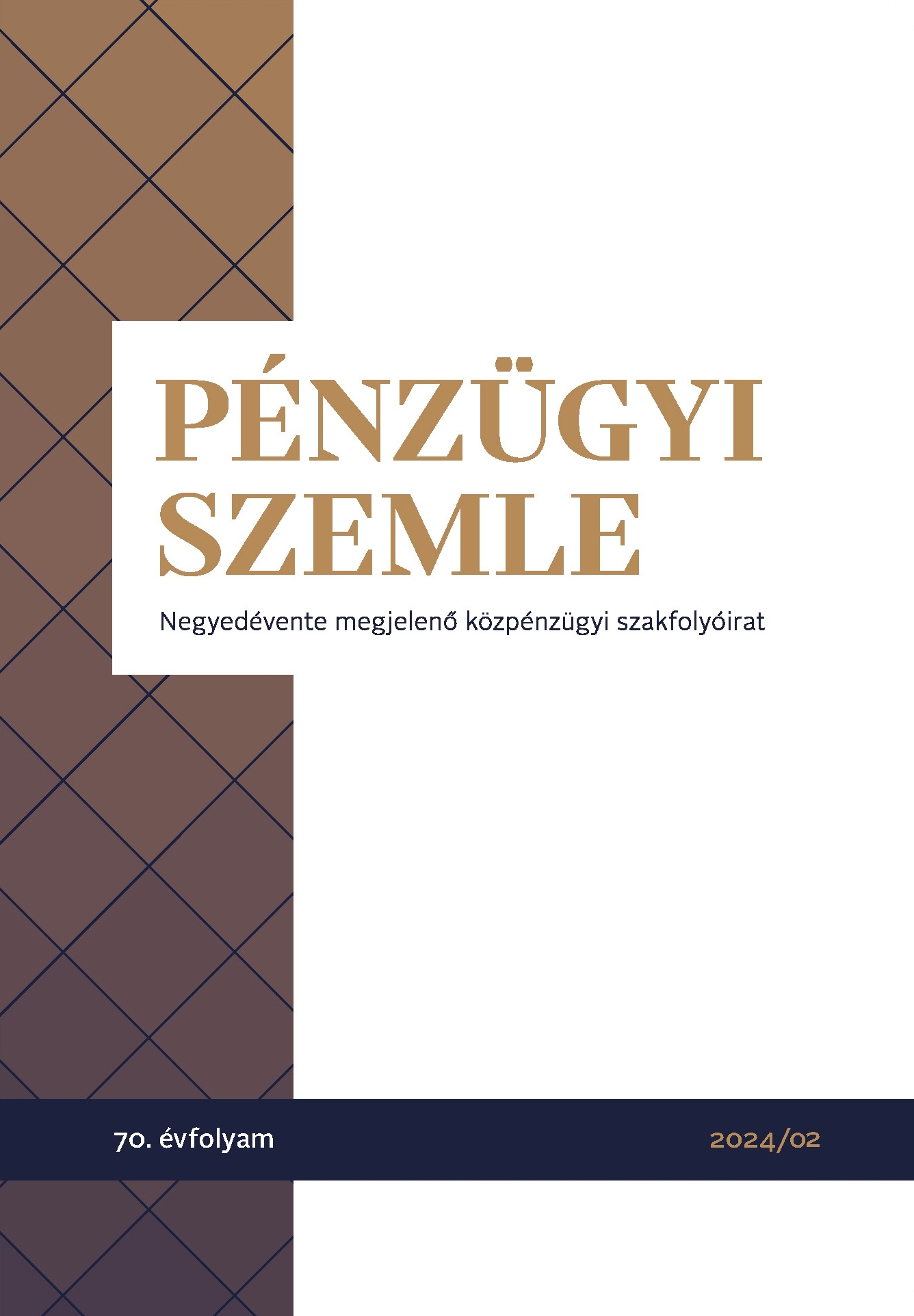Stock market decision-making in the light of prospect theory
DOI:
https://doi.org/10.35551/PFQ_2024_2_3Keywords:
stock market indices, butterfly-effect, financial crisis, correlation and regression, prospect theory, crisis theory, D53, D81, G11, G14Abstract
One of the main insights of prospect theory is that investment decisions are often irrational, following certain trends, and this is particularly true for individual investment decisions. The theory’s main proponents and its developers have described the phenomenon of risk seeking over losses and risk aversion over gains, mainly by looking at stock market trends. One of the hypotheses of our paper is that investors become risk averse in times of crisis. The other hypothesis is that the hummingbird effect can be detected in stock market trading. Using linear regression, we have been able to show that investors become more risk averse in times of crisis, which can also be seen in stock market trading, through the shift in the index. In addition, we have also been able to show that the hummingbird effect can also be detected in stock market trading.
References
Akhtar S. and Shah S. M. A., (2021), A Stock Market Reaction to Firm Leverage: An Investors’ Insight from Developing Economy of Pakistan, Journal of Legal, Ethical and Regulatory Issues Volume 24, Special Issue 6, 2021 pp 37-55.
Ayroza I. F. L., Iwamoto H., Rodrigues W. (2018), The old and the new Behavioral Economics: highlights of a trajectory, Textos de Economia, v. 21 n. 2, pp. 50–72 DOI: 10.5007/2175-8085.2018v21n2p50
Baddeley M. (2017), Behavioural Economics. A Very Short Introduction. Oxford University Press.
Baddeley M. (2019a), Behavioural Economics and Finance, Routledge.
Baddeley M. ( 2019b), The Unfolding Landscape of Behavioral Economics: from the past to the future, Journal of Behavioral Economics for Policy, Vol. 3, No. 1, pp. 5-11.
Bélyacz I. ( 2014), A financializáció szerepe a globális pénzügyi válság kialakulásá-ban, Hitelintézeti Szemle, XIII. évf., 1. sz. pp 28-43.
Burton E. T., Shah S. N. (2013), Behavioral Finance. Understanding the Social, Cognitive and Economic Debates, Wiley Publishers.
Camerer C. F., Loewenstein G, Rabin M. ( 2004), Advances in Behavioral Economics, Princeton University Press.
Corr P., Plagnol A. (2019), Behavioral Economics. The Basics, Routledge.
Dhami S. (2016), The Foundations of Behavioral Economic Analysis, Oxford University Press.
Ferguson N. (2021), Végzet. A katasztrófa politikája, Budapest, Scolar Kiadó.
Foo, A. T.-L., Wahidudin, A. N., & Chie, Q.-T. (2020). Overconfidence, Experien-ce and Passive Investing. Journal of Contemporary Issues and Thought, 10, 25-35. DOI: https://doi.org/10.37134/jcit.vol10.sp.3.2020
Götz G ( 1993), A pillangó-effektus. A káosz felfedezése a meteorológiában. Fizikai Szemle, 1993. No 12. p 487.
Gurevich G., Kliger D., Levy O. (2009), Decision-making under uncertainty – A field study of cumulative prospect theory, Journal of Banking & Finance, Volume 33, Issue 7, July 2009, Pp 1221-1229 https://doi.org/10.1016/j.jbankfin.2008.12.017
Győrffy D. ( 2009), Szép új világ Amerikában, Pénzügyi Szemle. -54 : 2-3 (2009), p. 318-338.
Hamar F. ( 2013), Egy pszichológus aki közgazdasági Nobel-díjat kapott: Dani-el Kahneman, Multidiszciplináris kihívások – sokszínű válaszok: a BGF KVIK KÖT tanulmánykötete. Budapest, Budapesti Gazdasági Főiskola Kereskedelmi, Vendég-látóipari és Idegenforgalmi Kar, pp. 41-59.
Hasan, F., Kayani, U.N. & Choudhury, T. (2023), Behavioral Risk Preferences and Dividend Changes: Exploring the Linkages with Prospect Theory Through Empirical Analysis. Global Journal of Flexible System Management 24, 517–535 . https://doi.org/10.1007/s40171-023-00350-3
Hámori B. (2003), Kísérletek és kilátások. Daniel Kahneman, Közgazdasági Szemle, 1. évf. pp 779-799.
Kahneman D., Tversky A. (1979), Prospect Theory: An Analysis of Decision Under Risk. Econometrica, Vol 47. No 2. pp 263-292. https://doi.org/10.2307/1914185
Kaustia M. (2010), Prospect Theory and the Disposition Effect The Journal of Financial and Quantitative Analysis, Vol. 45, No. 3. pp. 791-812 DOI: https://doi.org/10.1017/S0022109010000244
Kostolany A. (1990), A pénz és a tőzsde csodavilága, Budapest, Közgazdasági és Jogi Könyvkiadó.
Kunreuther H. C., Paully M. V., McMorrow S. (2013), Insurance and BehavioralEconomics. Improving Decisions in the Most Missunderstood Industry, Cambridge University Press.
Levine D. K. ( 2009), Is Behavioral Economics Doomed? The Ordinary vs the Extraordinary, Max Weber Lecture, June 8, 2009.
Levy H., Levy M., ( 2004), Prospect Theory and Mean-variance Analysis, The Review of Financial Studies, Volume 17, Issue 4, October 2004, Pages 1015–1041, DOI https://doi.org/10.1093/rfs/hhg062
Lorenz E. N. ( 1972) Predictability: Does the Flap of a Butterfly’s Wings Set Up a Tornado in Texas? , Hjemmesidehenvisning Øvelse 6.13 Kapitel 6.
Mullainathan S. (2007), Psychology and Development Economics, pp 85-114. In Diamond P., Vartainen H.(eds.) Behavioral Economics and Its Applications, Princeton University Press, 2007
Nagy B. Zs. (2007), Új irányvonal a gazdaságelméletben: viselkedés-gazdaságtan, Közgazdász Fórum, nr. , pp 3-16
Orrell D. (2021) Behavioural Economics. Psychology, neuroscience and the human side of economics, London, Icon Books.
Rajagopal ( 2015), The Butterfly Effect in Competitive Markets. Driving Small Changes for Large Differences, Palgrave MacMillan
Schleifer, A. (2000) Inefficient Markets. An Introduction to Behavioral Finance, Oxford University Press
Sibanda V. (2020), Determinants of Investment Decisions: A Study of Individual Investors on the Zimbabwe Stock Exchange, Applied Economics and Finance vol. 7. No. 5. pp 38-53 DOI: 10.11114/aef.v7i5.4927
Singh Y., Adil M., Haque S. M. I., (2023), Personality traits and behaviour biases: the moderating role of risk-tolerance, Quality & Quantity, nr. 57, pp 3549–3573 , DOI https://doi.org/10.1007/s11135-022-01516-4
Sinha T. (1994), Prospect theory and the risk return association: Another look, Journal of Economic Behavior and Organization, vol. 24, pp 225-231 , https://doi.org/10.1016/0167-2681(94)90029-9
Sornette D. (2009) Dragon-Kings, Black Swans and the Prediction of Crises, Swiss Finance Institute Research Paper No. 09-36
Taleb N. N. (2010), The Black Swan: The Impact of the Highly Improbable, Random House Publishers.
Thaler R. H. (2015), Misbehaving. The Making of Behavioral Economics. New York & London, W W Norton and Company.
Wei Y. (2023), , The Prospect Theory and The Stock Market, Highlights in Business, Economics and Management, Volume 11, pp 217-221. DOI: 10.54097/hbem.v11i.8101
Wucker M. (2016), A szürke rinocérosz. Hogyan ismerjük fel a világunkat fenyege-tő nyilvánvaló veszélyeket, Budapest, Athenaeum Kiadó.
Zhang W-B., ( 2021), The Butterfly Effect in China’s Economic Growth, Palgrave MacMillan.
Downloads
Published
How to Cite
Issue
Section
License
Authors assign copyright to Pénzügyi Szemle / Public Finance Quarterly. Authors are responsible for permission to reproduce copyright material from other sources.












